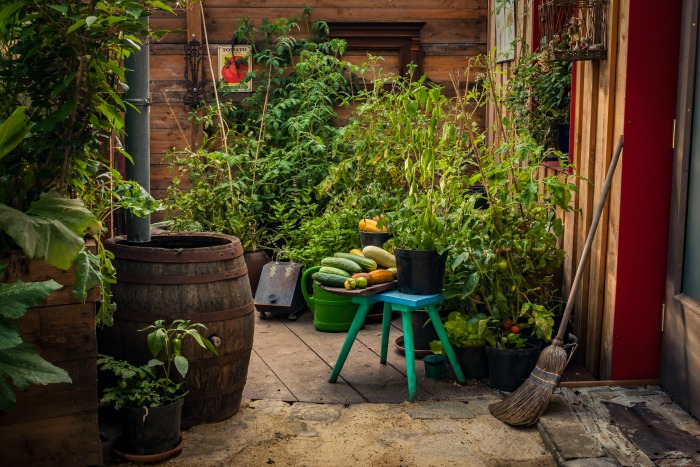
I utilized my lack of space with a patio garden where I had herbs, vegetables, and berries growing. As well, I had pots of fruit trees started and vertical gardening systems hanging so I could make use of as much space and lighting as possible.
When we don’t have the option of moving out into the sprawling countryside to live off of the land, we have to make use of what we have. Urban and suburbanites can garden in their small spaces using some of the most popular vertical gardening and small space gardening techniques:
- Vertical gardening systems
- Window boxes
- Grow bags
- Ceramic containers
- Pallets
- Hanging planters
Container Plants Prefer Lots of Drainage
Ensure that your pots and containers have adequate drainage holes at the bottom. Plants do not like to sit in soggy soil and will quickly develop root rot, as a result. Plant shallow-rooted plants such as small herbs, green leafy vegetables, strawberries, and green onions which can be grown close to one another and will help plant roots stay shaded from the hot sun. This is a principle of xeriscaping and will also help to cut down on watering.
To keep plants healthy, water only when the soil feels dry. The best way to determine when to water is to insert your index finger 2-3 inches into the soil. If the soil feels dry, it needs water. If it is still moist, then it can go another day until it needs to be watered.
Because the plants will not be getting essential nutrients from the ground, you need to ensure that the soil you use is suitable for containers. Ensure your potting mix has everything the plant needs to thrive – perlite, vermiculite, calcined clay (kitty litter), and sand are the mineral aggregates most commonly used in potting soils. Adding these would be beneficial to the success of your garden. As well, adding 1/2 cup of dolomitic limestone, greensand, rock phosphate, and kelp powder will give your plants additional nutrients for growing.
What Kind of Plants to Grow?
Growing compact plants with smaller root systems is another way to garden in small spaces. Herbs such as oregano, rosemary, thyme, lavender, and sage grow well in containers and do not need to be replaced each season, thus making them wonderful additions to a year-round patio garden.
Make a concerted effort to purchase heirloom quality seeds. These types of seeds are bred for their flavor and not their durability for shipping and mass distribution. Additionally, these seed types will produce fertile seeds that can be saved for subsequent growing seasons, which many sustainable-minded folks prefer. The following is a list of seasonal plants that grow well in containers:
Fall/Winter
Utilizing cold frames can help protect smaller, less established plants during bouts of freezing weather.
- Greens such as lettuce, spinach, mustard greens, kale
- Cabbage
- Broccoli
- Carrots
- Turnips
- Onions
- Garlic
- Radishes
- Potatoes
- Most herbs
Spring/Summer
- Tomatoes (requires staking)
- Peppers
- Cucumbers (requires a trellis)
- Green beans
- Fruit trees
- Berries
As well, consider adding some colorful flowers such as petunias, marigolds, or roses to attract beneficial insects to help pollinate your patio garden.
As one wise man once said, “There are never problems, only solutions.” Even though you may not live on acreage, you can still enjoy organic, homegrown vegetables and fruits from the convenience of your patio. This small investment will help your family save money at the grocery store, eat healthily, and have lovely scenery to enjoy during the summer months.
This article was originally published at Ready Nutrition™ on January 27th, 2018







I’ll be enclosing my south-facing (roofed) porch with greenhouse plastic when the SHTF, for it to act as a greenhouse (10×16).
I insulated up under the tin roof with 3/4″ foam board, keeps it from roasting in summer (NW Florida), and will hold some warmth in winter when I enclose it.
I recently bought (for $11 on ebay), a SEED tray heating mat (would be great to have something like this warming up under the containers to give a boost for the roots)….but I also find it a GREAT FOOT warmer at the computer desk or while watching TV.. and it only consumes 18w of power.
It can also be used as a pet-bed warmer, or perhaps in with the baby chicks?
I used it for a few nights, on top of my bed mattress (but under the bed pad and bottom sheet) to keep my feet warm on those extra cold nights. I also tried it “over the feet” but it quickly shifted out of position.
One BIG item missing from the container gardening list is MUSHROOMS.
I’ve read, that in a 3ft X 3ft closet space (in total darkness) you can grow up to 100 pounds of Oyster mushrooms in a year.
Don’t like mushrooms? Don’t worry, because plenty of people DO like them and can’t grow them and may gladly TRADE for them.
Mushroom supplies are available online, of course, Amazon, Ebay, etc etc
I live in an apartment and the windows have great light all day. However, we are moving soon a d looking for a townhouse with a backyard. Pray we find one.